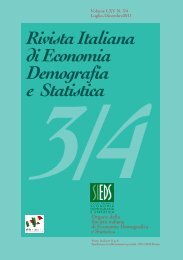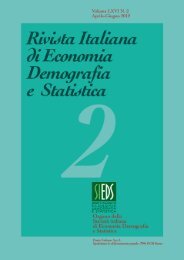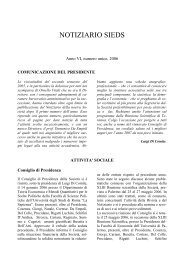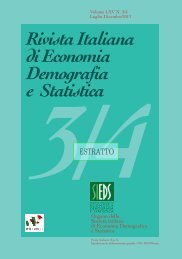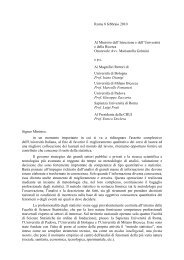rivista italiana di economia demografia e statistica - Sieds
rivista italiana di economia demografia e statistica - Sieds
rivista italiana di economia demografia e statistica - Sieds
Create successful ePaper yourself
Turn your PDF publications into a flip-book with our unique Google optimized e-Paper software.
Rivista Italiana <strong>di</strong> Economia Demografia e Statistica Volume LXV n. 1 – Gennaio-Marzo 2011<br />
1. Introduction<br />
MULTIDIMENSIONAL POVERTY ACROSS EUROPE<br />
Martina Celidoni, Isabella Procidano, Luca Salmasi<br />
Recently the analysis of poverty has evolved towards a multi<strong>di</strong>mensional<br />
perspective, considering not only the economic <strong>di</strong>mension, i.e. income or<br />
consumption, but also other attributes regarded as determinant for an acceptable<br />
living standard.<br />
The idea of enlarging the <strong>di</strong>mensions analysed is supported by several<br />
approaches: the basic-needs approach for instance regards poverty as lack of basic<br />
needs, also Sen’s capability approach sees poverty as inability of possession of a<br />
wide range of characteristics related to the living standard, while the social<br />
exclusion perspective argues that poverty can be considered as an exclusion of<br />
in<strong>di</strong>viduals from standard way of living and basic social activities. All those<br />
approaches criticize the uni-<strong>di</strong>mensional analysis because limiting and argue that<br />
focusing the attention on poverty only as lowness of income depicts an incomplete<br />
picture of the phenomenon, sometimes with mislea<strong>di</strong>ng conclusions (Madden,<br />
2008).<br />
With the aim of a more richer description of poverty in Europe, among elderly<br />
people, our paper adopts a multi<strong>di</strong>mensional approach, considering as measure of<br />
well-being not only income but also health. Moreover the focus on elderly people<br />
is driven mainly by the fact that this part of the population has become relevant due<br />
to the substained aging process that Europe has occured in the last decades. We are<br />
interested therefore in comparing poverty across Europe, in terms of income and<br />
health, for a more and more preeminent part of the population.<br />
The development of multi-<strong>di</strong>mensional poverty is intrinsically motivated not<br />
only by the recognition that deprivation may occur in more than one <strong>di</strong>mension but<br />
also by the fact that the correlation between <strong>di</strong>fferent <strong>di</strong>mensions of deprivation<br />
may not be perfect. If the aim is to identify poors and the correlation would be<br />
perfect in fact, the choice of the <strong>di</strong>mension upon which to measure the incidence of<br />
poverty is unimportant, since all <strong>di</strong>mensions will identify the same in<strong>di</strong>viduals as<br />
poor but if the degree of correlation between <strong>di</strong>mensions decreases, the case of a<br />
multi-<strong>di</strong>mensional approach becomes more persuasive (Madden, 2008). Using the<br />
Receiver Operating Characteristics curve (ROC) approach, we will examine the



